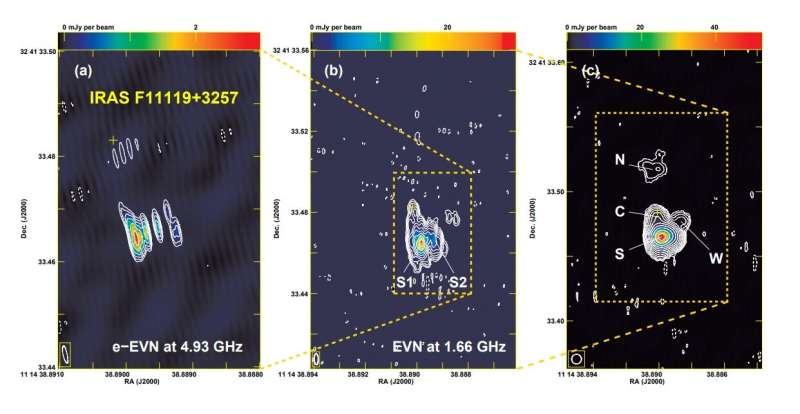The two-sided but significantly beamed jet observed with the EVN in the highly accreting quasar IRAS F11119+3257. Credit: Yang et al., 2020.
Astronomers have carried out very-long-baseline interferometric (VLBI) observations of the quasar IRAS F11119+3257 using the European VLBI Network (EVN). They found that the object has a high velocity two-sided jet, a finding detailed in a paper published March 25 on the arXiv pre-print repository.
Powered by supermassive black holes (SMBHs), quasars, or quasi-stellar objects (QSOs) are extremely luminous active galactic nuclei (AGN) with luminosities even thousands of times greater than that of the Milky Way galaxy. Most quasars are known to eject huge amounts of material into their host galaxies. Hence, detecting and observing such outflows could provide important hints about the evolution of galaxies.
At a redshift of 0.189, the quasar IRAS F11119+3257 is a type 1 ultraluminous infrared galaxy (ULIRG) and hosts strong molecular outflows, with the emission dominated by the AGN. It is assumed that the outflows from this source could be caused by radio jet or by radiation pressure from the disk emission and disk winds.
In order to verify this scenario, a team of astronomers led by Jun Yang of Chalmers University of Technology, Sweden, conducted high-resolution VLBI observations IRAS F11119+3257, which provided more information about its radio structure.
"We observed IRAS F11119+3257 with the EVN at 1.66 and 4.93 GHz in 2016. (...) The full EVN observations at 1.66 GHz were carried out in the disk-recording mode on March 8," the astronomers wrote in the paper.
In general, the radio spectrum of IRAS F11119+3257 between 0.15 and 96 GHz shows a peak at around 0.53 GHz and a steep slope in the optically thin part. EVN observations at 1.66 and 4.93 GHz show that the quasar has a two-sided jet with a projected separation of about 650 light years and a very high flux density ratio of about 290.
By analyzing flux density ratios between the approaching and receding jet components, the researchers calculated that the jet has an intrinsic speed of at least 0.57 times of the speed of light. This is the highest speed among all the known highly accreting objects, which allowed the researchers to draw first conclusions regarding the jet's origin.
"We inferred that the jet has an intrinsic speed of ≥ 0.57c. This is higher than that observed in the X-ray winds and is thus unlikely to be driven by the radiation pressure alone," the scientists concluded.
Furthermore, based on the observed broad-band radio spectrum, the astronomers assume that IRAS F11119+3257 is a Gigahertz-peaked spectrum (GPS) source or a compact steep-spectrum source (CSS). According to the authors of the paper, the most plausible explanation is that the studied quasar is an uncommon compact symmetric object (CSO), a subtype of GPS. This assumption was made based on the object's two-sided jet morphology, compact size and exceptionally high flux density ratio.
More information: A two-sided but significantly beamed jet in the supercritical accretion quasar IRAS F11119+3257, arXiv:2003.11427 [astro-ph.HE] arxiv.org/abs/2003.11427
© 2020 Science X Network
























